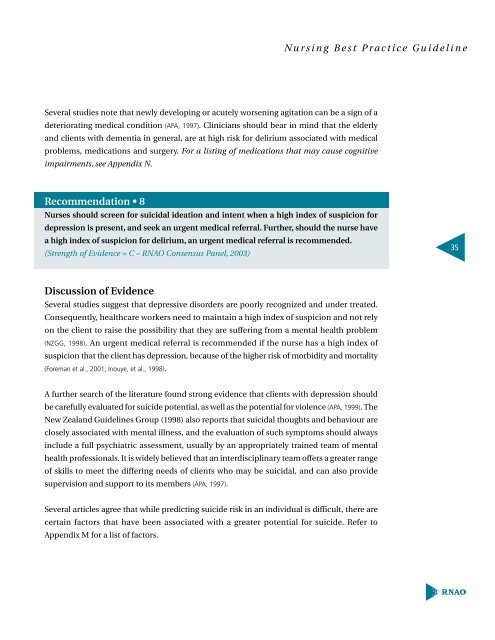Screening for Delirium, Dementia and Depression in Older Adults
Screening for Delirium, Dementia and Depression in Older Adults
Screening for Delirium, Dementia and Depression in Older Adults
- No tags were found...
Create successful ePaper yourself
Turn your PDF publications into a flip-book with our unique Google optimized e-Paper software.
Nurs<strong>in</strong>g Best Practice Guidel<strong>in</strong>eSeveral studies note that newly develop<strong>in</strong>g or acutely worsen<strong>in</strong>g agitation can be a sign of adeteriorat<strong>in</strong>g medical condition (APA, 1997). Cl<strong>in</strong>icians should bear <strong>in</strong> m<strong>in</strong>d that the elderly<strong>and</strong> clients with dementia <strong>in</strong> general, are at high risk <strong>for</strong> delirium associated with medicalproblems, medications <strong>and</strong> surgery. For a list<strong>in</strong>g of medications that may cause cognitiveimpairments, see Appendix N.Recommendation • 8Nurses should screen <strong>for</strong> suicidal ideation <strong>and</strong> <strong>in</strong>tent when a high <strong>in</strong>dex of suspicion <strong>for</strong>depression is present, <strong>and</strong> seek an urgent medical referral. Further, should the nurse havea high <strong>in</strong>dex of suspicion <strong>for</strong> delirium, an urgent medical referral is recommended.(Strength of Evidence = C – RNAO Consensus Panel, 2003)35Discussion of EvidenceSeveral studies suggest that depressive disorders are poorly recognized <strong>and</strong> under treated.Consequently, healthcare workers need to ma<strong>in</strong>ta<strong>in</strong> a high <strong>in</strong>dex of suspicion <strong>and</strong> not relyon the client to raise the possibility that they are suffer<strong>in</strong>g from a mental health problem(NZGG, 1998). An urgent medical referral is recommended if the nurse has a high <strong>in</strong>dex ofsuspicion that the client has depression, because of the higher risk of morbidity <strong>and</strong> mortality(Foreman et al., 2001; Inouye, et al., 1998).A further search of the literature found strong evidence that clients with depression shouldbe carefully evaluated <strong>for</strong> suicide potential, as well as the potential <strong>for</strong> violence (APA, 1999). TheNew Zeal<strong>and</strong> Guidel<strong>in</strong>es Group (1998) also reports that suicidal thoughts <strong>and</strong> behaviour areclosely associated with mental illness, <strong>and</strong> the evaluation of such symptoms should always<strong>in</strong>clude a full psychiatric assessment, usually by an appropriately tra<strong>in</strong>ed team of mentalhealth professionals. It is widely believed that an <strong>in</strong>terdiscipl<strong>in</strong>ary team offers a greater rangeof skills to meet the differ<strong>in</strong>g needs of clients who may be suicidal, <strong>and</strong> can also providesupervision <strong>and</strong> support to its members (APA, 1997).Several articles agree that while predict<strong>in</strong>g suicide risk <strong>in</strong> an <strong>in</strong>dividual is difficult, there arecerta<strong>in</strong> factors that have been associated with a greater potential <strong>for</strong> suicide. Refer toAppendix M <strong>for</strong> a list of factors.
















